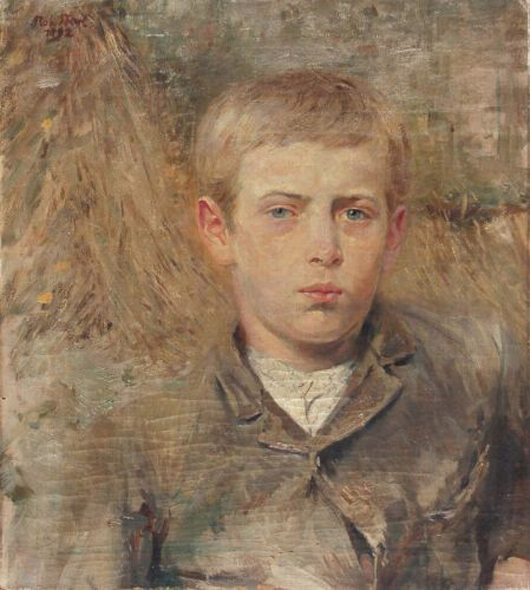
In light of this, it is not surprising that the most important agenda item for the Bundesverband deutscher Kunstversteigerer (BDK) is “Fighting Forgeries.” The organized group of German art auction houses has actually been doing this for some time.
“I initiated the Databank of Questionable Works (Datenbank der kritischen Werke) about five years ago for the BDK,” said Markus Eisenbeis, director and auctioneer for Van Ham Kunstauktionen, Cologne.
He originally envisioned the databank as a place where the members of the BDK could enter and share information on questionable works of art. The database was not meant to be a list of forged works, but a list of pieces with a doubtful provenance or problematic histories. The information in the databank was to be maintained and expanded only by BDK members.
“However, because the acceptance of this lagged behind my expectations, I permitted the databank to become a budgeted project when I was vice president of the BDK in 2009,” said Eisenbeis. “The funds went to diverse experts, artist heirs and archives to enter recorded forgeries into the databank. Consequently there are meanwhile over 1,000 works documented and the database has a solid foundation for further expansion.”
Eisenbeis and the BDK are still weighing the legal and financial responsibility required if the databank is expanded to include other German art organizations. Only when the cooperation and financial support of the German art organizations are in place, does Eisenbeis foresee linking the database to other art organizations internationally. The sharing of this information with other art professionals could greatly hinder the incidence of forgeries on the international art scene.
In the case of the alleged German art forgery scandal, the operational tactics were especially insidious. No one walked into a gallery carrying a copy of Leonardo da Vinci’s Mona Lisa. That would have been too obvious. Instead, lesser known artists of the early 20th century were targeted – Johannes Molzahn, Heinrich Campendonk and Max Pechstein, among others. The paintings were considered to be unknown, not appearing in the artist’s own inventories and never having been photographed. Provenance was convincing, but fictional.
“In reality it is only possible to prove provenance with much difficulty, when one gets no information from the person who brings in (the artwork). Often it is the heir who has inherited the piece with no documentation and also has no knowledge himself of where the work has come from,” said Eisenbeis. “This is generally valid for the lower price segment, especially for Arts and Crafts pieces that are often not one-of-a-kind.”
Eisenbeis recommends that people shopping for authentic artwork never try to find a bargain, and buy only through serious auction houses and art dealers. They should have, whenever possible, a certificate written by an internationally known art expert.
“With artists whose work is expensive, there is the danger of forgery. With such artists it is often not the oil paintings, but especially the watercolors and drawings that are forged, because these are often not completely documented,” said Eisenbeis. “There is also danger with artists who have not left a competent estate, for example not taken care to archive their work.”
As auctioneer, Eisenbeis treads carefully when a masterwork from Rubens or Picasso is offered to a German auction house. He is realistic enough not to imagine it is a first choice masterwork. He recommends suspicion when important, expensive artwork is offered for value prices and there is no competition to buy it. Paintings over 100 years old in perfect condition also set off warning bells for him, as do rare works that pop up too often.
“In early 2010, for example, we auctioned a painting by Expressionist Arnold Topp from the year 1918. In autumn we were again offered a painting from this year. Another auction house also had a work in early 2010 from 1918,” said Eisenbeis. “In autumn I contacted my colleague from the other auction house, and he also had a second work from 1918. When both pieces were scientifically examined, one was determined to be a forgery. Thank God not the one from our auction house.”
Science, it seems, can be very revealing. One of the paintings involved in the alleged forgery scandal is said to contain a paint color formulation that was not available at the time the work was supposedly painted. This stroke of modern color was the red flag that led to further investigation. And while the full extent of the damage is not yet known, even museum collections may be effected.
Meanwhile Eisenbeis and the BDK continue their project to make the purchase of authentic artwork more secure. Eisenbeis expects to resume talks with other German art organizations this year in order to further expand the BDK Database of Questionable Works.
The Final Tally
The Hoffmeister Collection of Meissen Porcelain, auctioned in three sales by Bonham’s London, gleaned close to a total of 3,553,000 euros (about $5 million). The sale put many of the pieces back into the hands of the original families who once owned them. Princess Gloria von Thurn und Taxis retrieved a Meissen saucer made for a Thurn und Taxis armorial service with a winning bid of just over 6,390 euros ($8,834). Only two other recorded pieces of this armorial service still exist.
Another astonishing auction result was the December 2010 hammer price for Kinderköpfchen by Ernst Ludwig Kirchner at Ketterer Kunst, Munich. This 1906 transitional Expressionist work breezed past its estimate of 400,000 euros (just over $550,000) to finish at 1,740,000 euros ($2,406,107).
In other news, Doebele Galerie + Kunstauktionen have moved into their new branch offices at Gartenstraβe 3 C in Berlin. The space is near their existing gallery, which is currently displaying “Max Ackermann – Late Pastels.”
Upcoming Auctions
February
15 – Quittenbaum Kunstauktionen, Munich. “La Dolce Vita“ Design und Murano Glass; The Dolf Selbach Collection of Jugendstil glass. www.Quittenbaum.de
15 and 16 – Gerhard Hirsch Nachfolger, Munich. 1,400 Antique Art Objects in glass, stone, clay and metal.; Feb. 17 and 19. Coins and Medallions. www.Coinhirsch.de
March
3 and 4 – Yves Siebers Auktionen GmbH, Stuttgart. Art, Antiques and Toys, including the collection of Majolica Manufacturers like M. Heinze, W. Süss and A. Müller. www.Siebers-Auktionen.de
5 – Schmidt Kunstauktionen, Dresden. Artwork from the 17th to 21st Century. www.Schmidt-Auktionen.de
12 – Anticomondo GmbH, Cologne. Toy Auction. www.Anticomondo.de
12 – Leipziger Münzhandlung und Auktion Heidrun Höhn. Coins and Medallions. www.Numismatik-Online.de
14 to 17 – Preview at Sotheby’s, Amsterdam; auction at the Rai Theatre, Amsterdam. Property from the Estate of Queen Juliana of the Netherlands to be sold for the benefit of charity. www.Sothebys.com
26 – Auction Team Breker, Cologne. Photographica and Film. www.Breker.com
ADDITIONAL IMAGES OF NOTE




